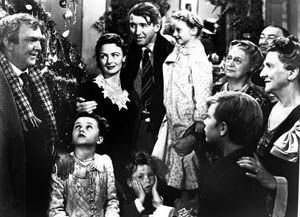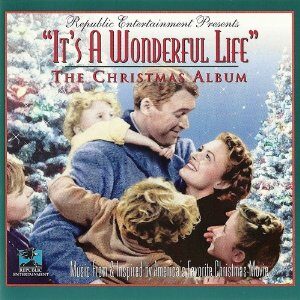
The Film:
It ranked high on the American Film Institutes Top 100 List (No. 11 in 1998) and the film was No. 1 on its “100 Cheers” list.
Here are the nominees and one Oscar received for this 1946 film (from Wikipedia):
| Category | Result | Nominee / winner |
|---|---|---|
| Best Picture | Nominated | Frank Capra | Winner: Samuel Goldwyn – The Best Years of Our Lives |
| Best Director | Nominated | Frank Capra | Winner: William Wyler – The Best Years of Our Lives |
| Best Actor | Nominated | James Stewart | Winner: Fredric March – The Best Years of Our Lives |
| Best Film Editing | Nominated | William Hornbeck | Winner: Daniel Mandell – The Best Years of Our Lives |
| Best Sound Recording | Nominated | John Aalberg | Winner: John P. Livadary – The Jolson Story |
| Technical Achievement Award | Won | Russell Shearman and RKO Radio Studio Special Effects Dept. for the development of a new method of simulating falling snow on motion picture sets |
Surprisingly, even though it received six Oscar nominations, the film only received mixed reviews when it premiered on December 20, 1946 at the Globe Theater in New York and then nationwide on Christmas Day.
It took several decades to attain the popularity it now has after the film was shown on hundreds of television stations after it became a film in public domain. It is now one of the all-time film favorites, especially during the Christmas season and has a 94% rating from the film critics on the Rotten Tomatoes site.
I first watched the film on television many years ago and I have loved it ever since.
Like many who love this film, I’ve continued to follow it through all the various media technologies — first on VHS tape, then on DVD and most recently on a 75th anniversary Blu-ray which includes both the original black and white film and a colorized version.
The black & white original remains the best since it was filmed that way and for good reason since the contrast between good and evil is much more apparent with the black and white cinematography. It really is a rather dark story at least until the end. The colorized version distorts that original concept.
The film was directed by Frank Capra who said it was his favorite film. Likewise for one of its stars, James Stewart, and his co-star Donna Reed said it was one of her favorites as well.
There is a stellar supporting cast, including: Lionel Barrymore, Ward Bond, Frank Faylen, Thomas Mitchell, Beulah Bondi, Gloria Grahame, Henry Travers, H.B. Warner, and those adorable Bailey youngsters: Bobbie Anderson (young George), Larry Simms (Peter), Carol Coombs (Janie), Karolyn Grimes (Zuzu), and Jimmy Hawkins (Tommy). Several of these youngsters have since become celebrities when they were older, especially Karolyn Grimes who has had a thriving business selling memorabilia from the film. Many have been touched by her stories about the film in her newsletter and on her personal appearance tours. The interest in this film and its message of hope winning over despair remains strong.
The Score:
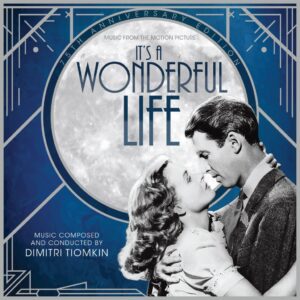
Album Produced for LaLa Land Records by Dan Goldwasser.
Executive Album Producers for LaLa Land Records: M.V. Gerhard and Matt Verboys
Album Restoration and Mastering: Chris Malone
2. Ski Run – 1:31
3. Death Telegram – 1:59
4. Gower’s Deliverance – 2:03
5. George and Dad – 1:45
6. Father’s Death – 0:30
7. Love Sequence – 2:12
8. Dilemma – 0:37
9. Bank Crisis – 0:55
10. Wedding Cigars – 0:41
11. George Lassoes Stork – 2:03
12. This Is The Army, Mr. Jones/ Dankgebet – 2:20
13. Uncle Billy’s Blunder – 1:15
14. Search For Money – 2:01
15. Potter’s Threat – 0:50
16. Clarence’s Arrival – 2:20
17. George Is Unborn – 2:24
18. Haunted House (With Chorus) -2:40
19. Pottersville Cemetery – 1:14
20. Wrong Mary Hatch/ The Prayer – 2:05
24. Main Title (Film Version) – 1:16
25. Father’s Death (Alternate) – 0:21
26. Wedding March – 0:51
27. Big Band – 0:20
29. Pottersville Cemetery (Without Chorus) – 1:19
31. Trailer Music – 1:03
Total Disc Time = 51:43
The booklet notes are by Frank K. DeWald, and they are excellent and well worth reading.
Sound quality, thanks to the dedicated work of Chris Malone, is as good as you’re probably going to get from such a vintage 1940s soundtrack.
Of special value are the bonus tracks which let you hear additional takes left out of the film.
This song was actually a big hit at that time as arranged with new words and titled, “Danced With A Dolly (With A Hole In Her Stocking),” written by songwriters Terry Shand, Jimmy Eaton and David Kapp in 1944. The song was featured on a popular radio show, ” Your Hit Parade,” and was a big hit for The Andrews Sisters. Another song used by Tiomkin was “Twinkle, Twinkle Little Star” representing Clarence Odbody AS2, played by the lovable actor, Henry Travers.
“The rising and falling phrases give this melody a wistful, yearning character quite in keeping with the film’s positive message.”
Unfortunately, the appealing love song was not included in the film and no cover versions were released either.
Luckily, this song has been included in the wonderful music collection, The Dimitri Tiomkin Anthology,
compiled by Warren M. Sherk, and published by Hal Leonard, 184 pages.
For a listing of all the songs and original score cues by Tiomkin,
see Michael Willian’s marvelous fact book (Chicago Review Press, 2006), pages 119-21:
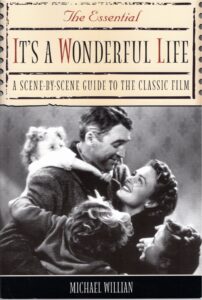
Even though there were six Oscar nominations, sadly Dimitri Tiomkin was not nominated for his film score.
But that wasn’t so troubling to him. There was something else on his mind.
In his autobiography with the great title of – Please Don’t Hate Me (1959), Tiomkin wrote about how some of his music was changed in the film. He wrote:
The picture was in the best Capra style. Frank thinks it the finest he ever made. I never saw it after it was completed.
After the music was on the sound track, Frank cut it, switched sections around, and patched it up, an all-around scissors job.
After that I didn’t want to hear it.
Stephen Cox in It’s a Wonderful Life: A Memory Book, expresses a similar opinion:
The film that eventually became one of Tiomkin’s most famous works actually became a disappointment for the composer,
both personally and professionally, when Capra replaced much of his original orchestration with existing music from other sources.
There were some awkward substitutions. One was Alfred Newman’s “Hallelujah” music from THE HUNCHBACK OF NOTRE DAME (1939), used instead of Tiomkin’s more appropriate quoting of Beethoven’s “Ode to Joy” in the scene near the end of the film where George Bailey jubilantly runs through town in the snow.
Cox mentions that Willard Carroll, found Tiomkin’s original score in the 1980s in the archives of the University of Southern California, writing that:
Carroll, along with composer and conductor David Newman, set out to release the unaltered Tiomkin score.
In 1988, their CD (which also includes suites from MIRACLE ON 34TH STREET and A CHRISTMAS CAROL)
was released by Telarc, with music richly recreated and recorded by London’s Royal Philharmonic Orchestra.”
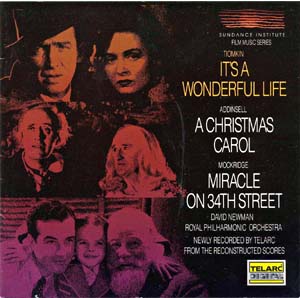
Even though these are not the complete three scores, this Telarc CD is definitely well worth having and is expertly conducted by David Newman.
Stephen Cox quotes Carroll as saying:
The score as it stands in the movie is a hodgepodge. Most of it is Tiomkin, but because of the accelerated release date, a great deal of it was chopped up, switched around, and in many cases, replaced by cues from other movies.
But what is left of Tiomkin’s music is well worth listening to for its appropriate accompaniment in many of the scenes.
One example is the dark ghost-like music Tiomkin wrote for the Pottersville Cemetery scene (track 19 – with chorus and track 29 – without chorus)
On this 75th anniversary of the film and the score, I give this new LaLa Land 75th anniversary CD my highest recommendation.
To quote from Chris Malone’s booklet notes: “The music of It’s A Wonderful Life serves as a fitting memento to one of the most beloved films of all time.”
In addition to the script, acting and direction, it is Tiomkin’s marvelous score which helps to make this such a “wonderful” film about “a wonderful life.”
–Review by Roger L. Hall, December, 2021
New Edition Now Available!
More about Dimitri Tiomkin’s film music and other film composers on this multimedia computer disc
with the complete book, plus bonus audio and video features:

A Guide to Film Music: Songs and Scores (PineTree Press, 8th edition, 2022)
To send in your comments about this article — click here

